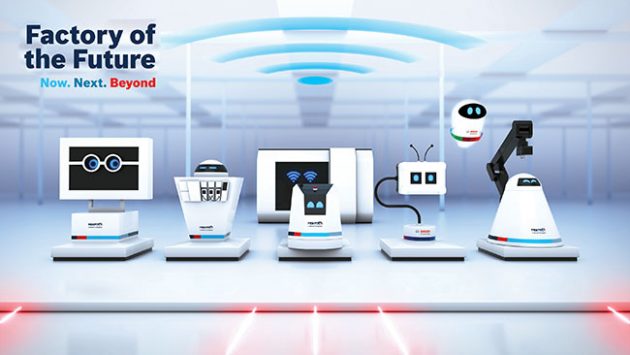
Built for the future
Canadian Packaging
Automation AI, AR, IoT, ML, VR Robotics Bosch Rexroth AG Factory of the Future Internet of ThingsLeading industrial automation manufacturer leverages digitalization and data acquisition to help pave the way for manufacturing transformation
Predicting the future is risky business at best, but it certainly helps when you’re in the driver’s seat of the future-bound technologies widely expected to be the fundamental building blocks of the next golden age of manufacturing in the industrialized world.
For leading German industrial automation giant Bosch Rexroth AG, the company’s designation as one of the leading forces behind the rapidly advancing Industry 4.0 manufacturing transformation rooted in seamless enterprise-wide date acquisition and real-time machine-to-machine communications is a well-earned badge of honor that accurately reflects its vast expertise in many industrial automation applications, including CPG (consumer packaged goods) production and packaging.
As one of the more prominent industrial technology powerhouses working tirelessly to promote the utilization so-called IIoT (Industrial Internet of Things) networking and connectivity into everyday manufacturing process and equipment operation, the company’s self-styled Factory of the Future (FOTF) doctrine of improving manufacturing productivity by leveraging analytics to optimize equipment uptime and human decision-making is a culmination of three years of intense research and development of Industry 4.0 principles and techniques at many of its own and manufacturing facilities around the world.

Asvin Parsad, Business Development Manager, Industry 4.0, Bosch Rexroth Canada
To get a better idea of FOTF has to offer to today’s fiercely competitive packaging industry, the Canadian Packaging magazine recently reached out to Asvin Parsad, business development manager for Industry 4.0 at Bosch Rexroth Canada, to explain why IIoT is the inescapable new reality for manufacturers in high-cost countries like Canada.
What is the main defining feature of FOTF that makes it such a transformational development?
Our vision of the FOTF is complete flexibility, whereby only the factory walls, the floor and the ceiling will be fixed, but everything else will be mobile.
The assembly lines will be modular, and their constituent machines will be moved and reorganized into new lines for new purposes. They will communicate wirelessly with one another with other process functions and with Cloud-based IT systems.
The FOTF will provide full transparency in the digitalized value stream: from procurement to production and right through to the customer.
What prompted Bosch Rexroth to develop the FOTF business model in the first place?
Our FOTF vision was a response to what we and our customers (manufacturing plants) were facing as a result of profound changes in customer demands.
As consumers, we want our stuff cheap, quickly, to provide high quality, and to be customized for our needs, so that we have the flexibility to change our minds as taste changes.
That puts a huge pressure on the manufacturing process and the supply chain to balance efficiency, productivity and automation, while coping with shorter product life-cycle, higher product variability, and high quality expectations.
Which industries stand to gain the most from the implementation of Factory of the Future in their operations?
We have implemented elements of this FOTF vision in a broad range of manufacturing industries that include automotive, packaging, food, electronics, mining, forestry, and even the entertainment industry.
We found that the type of industry was less important in determining successful implementation than having the right behavioral profile and a set of core competencies that needed to be present in the organization.
Success would depend on whether they have a ‘Lean’ mindset and are adaptive to change, critical thinking and digital literacy, with a high value on data security.
These set of behaviors would allow the organization to best leverage data to improve their supply chain and embrace new business models that can emerge out of Industry 4.0 principles.
Please explain the relevance of Factory of the Future concept to the packaging sector.
We have had extensive exposure to high-performance packaging machines through our Bosch Packaging division. The common questions we get asked are: ‘How well does my machine actually perform? How do I make inexpensive adjustments in order to optimize productivity, quality and efficiency?’ and ‘How do I get started?’
Packaging machines are complex structures—essentially a ‘Black Box’ that need to be made transparent to see what is going on inside the machine.
To achieve that, we came up with an IoT Gateway hardware/software solution that could read the control commands, motion parameters and peripheral devices.
Some of the controllers were from third parties like Rockwell, Siemens, Beckhoff, etc., and because we needed to read their parameters too, and we did it using an open industry standard called OPC UA.
The environmental conditions could also affect the packaging process, so we needed to record additional data like humidity, temperature, vibration and we did it using our Bosch XDK and CISS sensors.
All that data was then pulled into the IoT Gateway, cleaned up, filtered and transported to the analytics engine on the cloud to make sense of it.
The customer was then able to generate a health report of the machine, determine when the drop in performance occurred, and what were the probable causes behind it.
They now had the tools to initiate corrective actions and make adjustments to improve their performance.

How is your FOTF vision different from the Industry 4.0 blueprints developed by other automation companies, like the afore-mentioned third-party manufacturers?
The main differentiation from our peers is that our Industry 4.0 offering was mainly ‘customer-driven,’ rather than be purely driven by product innovation.
The customers were our own Bosch plants, with specific problems to solve and we had to develop tools to address these demands.
As we developed concepts and prototypes, the plants provided a fertile ground for pilot projects, deploying innovative ideas and getting first hand feedback. We eventually wrapped these ideas into products, made iterative updates until they were ready to market.
One such product is our ActiveCockpit. (See top picture on opposite page) We were spending a lot of time and effort gathering, processing and reporting our daily production metrics and our KPIs (key performance indicators.
Often, by the time the information reached the right people, it was already outdated. So if there were an issue with logistics, machine failure or staffing, there would usually be delay until these were detected and reported, and by the time corrective actions were taken, major losses may have already been incurred.
We needed a way to automate that information gathering process from multiple sources, record deviations from our planned production, and communicate with our production teams and management—hence the birth of the ActiveCockpit.
How many of your customers have implemented FOTF so far to some extent, if not completely?
We developed this vision of FOTF based on over 150 real-life Industry 4.0 projects that we implemented in our own plants—ranging from high-volume, highly automated processes to small-volume, highly variable configurations.
At our Bethlehem plant in Pennsylvania, we have a multi-Product line that assembles various models of hydraulic valves, in various configurations and in small lots.
Through our ActiveAssist software technology, we use AR (augmented reality) and RFID (radio frequency identification) to track parts, project the assembly instructions on the work surface, and verify the execution of each step.
This has significantly shortened the onboarding period, reduced the amount of rework and failures in the field.
With this technology, we bring people to the forefront, and we see this as an opportunity to secure qualified jobs and bring manufacturing back to high-cost countries like Canada.
What do the companies need to have in place prior to embarking on their Factory of the Future journey?
From our experience, Lean Manufacturing is the pre-requisite for FOTF. The company needs to have a basic understanding their value stream, their inputs, process and outputs, and have a mindset of continuous improvement.
Having been through that process ourselves, we can also provide guidance and a roadmap towards the digital transition as well as pitfalls to avoid and the negative impacts that need to be considered along that journey.
Before making any investment in FOTF, you will need to begin with a vision of where you want your business to be in the future, then build a use case map and evaluate where your pressing needs are.
Do you have breakdown or maintenance issues? Do you know where to find your operation data? Do you know where your parts are? Do you have quality issues?
From there, you would be able to develop a concept of your own FOTF.
Then you can proceed identify a project to get started on a small scale, get comfortable with the technology, start trusting your data, and use that data to make incremental improvements in your processes.
How open is FOTF in terms of communication with other vendors’ technologies?
Open Standards are one of the seven pillars of our FOTF vision. In a connected world, we cannot operate in isolation.
We need to be able to connect to other data sources, vendors and devices, and we do that by adopting open industry standards.We also need to allow third parties the ability to access our devices and customize it to their needs.
We do that by providing software development kits (SDKs) to developers who can then write their own applications and access the core of our machine data for their own needs.
Through open standard we also facilitate data transportation to your preferred Cloud platform, whether it’s Microsoft Azure, AWS, Oracle or your own local storage.
We have packaged our IoT solutions in blocks so that the user is not tied to one vendor at such an early stage of their journey.
What are the key realistic benefits of FOTF implementation in the near term?
It will allow manufacturers to achieve at least these four things: Truly connect the factory by making all the information sources readily available.
Digitalize the value stream, by having a digital representation of your key processes from source to production to delivery—knowing what’s going on in the plant in real time.
Maximize your flexibility by being able to adapt quickly to change in consumer taste and ramping the output up or down, while remaining profitable.
Adding value with digital business models by creating new businesses and exploring new opportunities that previously was not possible.
Advertisement

